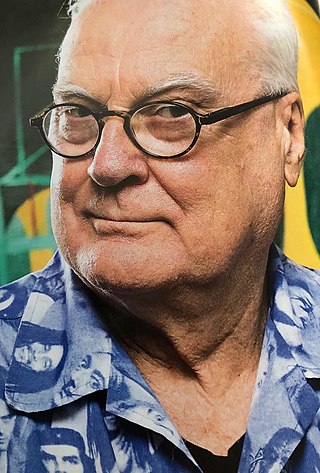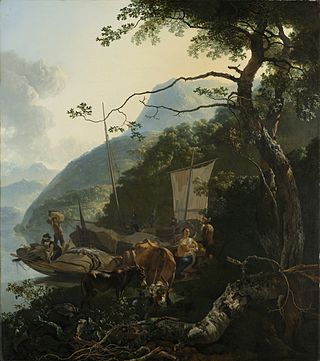Philip Brophy, born in Reservoir, Melbourne 1959 is an Australian musician, composer, sound designer, filmmaker, writer, [1] graphic designer, educator and academic.
Philip Brophy, born in Reservoir, Melbourne 1959 is an Australian musician, composer, sound designer, filmmaker, writer, [1] graphic designer, educator and academic.
In 1977, Brophy formed the experimental group → ↑ → more often written (though wrongly) as Tsk Tsk Tsk or Tch Tch Tch, [2] (pronounced tsk tsk tsk) with Ralph Traviato, Alan Gaunt and Leigh Parkhill. Sometimes compared to Andy Warhol's Factory, the group produced experimental music (Brophy on drums or synthesiser), films, videos, and live theatrical performances exploring Brophy's aesthetic and cultural interests, often on a minimal budget. Over the ten years of the group's operation it involved over sixty of Brophy's friends and acquaintances including musician David Chesworth, and visual artists Maria Kozic and Jayne Stevenson. They performed in a wide range of Australian venues including pubs, galleries, university campuses and the Clifton Hill Community Music Centre. They also performed or exhibited in Europe, including London's ICA. Brophy dissolved the group in the late 1980s, issuing a retrospective book "Made by → ↑ →", but continued to work with Kozic for some time.
In 1980, he founded the Innocent Records label with fellow Melbourne musician David Chesworth. Throughout the early 1980s, Brophy wrote numerous compositions and multi-media pieces. During 1985 he was the drummer in Olympic Sideburns. In the late 1990s, Brophy founded the Sound Punch label, and released both solo works, and collaborations with Maria Kozic, Bill McDonald, and fellow RMIT academic Philip Samartzis.
After the dissolution of → ↑ →, with whom Brophy had made numerous collaborative film and video works (including Super-8 and 16mm versions of No Dance), he set his ambitions on making higher budget films, and became more involved in sound design.
In 1988 he made an experimental short film Salt, Saliva, Sperm and Sweat. His first feature film, Body Melt , was released in 1993, and was funded by the Australian Film Commission and Film Victoria. Two short films were produced in 2004, The Sound Of Milk and Words In My Mouth - Voices In My Head (Anna).
Brophy has had works published in journals such as Virgin Press, Art & Text and Fast Forward and has presented papers at various film conferences since the early 1980s. He began teaching sound and media at the Phillip Institute of Technology in 1982. He began teaching cinema studies at RMIT in 1986.
Between 1985 and 2002 he co-presented, with Bruce Milne, the irreverent cultural theory and music radio show Eeek!, on Melbourne radio station 3RRR (102.7 MHz). At the time it was the most popular show on the station. Brophy has regularly written for The Wire magazine about film soundtracks, also Film Comment. He was the director of the Cinesonic International Conference on Film Scores & Sound Design, and has edited three journals from the conference.
He has had two books published by the British Film Institute, including 100 Anime, exploring Japanese animation. [3]
Philip Brophy has also exhibited his artworks in art galleries for exhibitions such as 'Vox' [4] and the Ian Potter Museum of Art [5] at the University of Melbourne.

The Little Band scene was an experimental post-punk scene which flourished in Melbourne, Victoria, Australia from late 1978 until early 1981. Instigated by groups Primitive Calculators and Whirlywhirld, this scene was concentrated in the inner suburbs of Fitzroy and St Kilda, and involved large numbers of short-lived bands, more concerned with artistic expression than commercial success. Frequently changing names, swapping members and sharing equipment, the bands played in small inner-city venues, often pubs, and their music was recorded live and broadcast by radio announcer Alan Bamford on community station 3RRR. In the scene, the distinctions between performers and audience were blurred; many audience members were either in little bands or ended up forming such.
Essendon Airport is an Australian electronic music, post-punk group formed in 1978 which explored experimental minimalist and funk music. Founding mainstays were the duo of David Chesworth on electric piano and drum machine and Robert Goodge on guitar. They were joined in late 1980 by Ian Cox on saxophone and Paul Fletcher on drums.
David Chesworth is an Australian-based interdisciplinary artist, composer and sound designer. Known for his experimental, and at times, minimalist music, he has worked solo, in post-punk groups, electronic music, contemporary ensembles and experimental performance. He has also created installation and video artworks with collaborator Sonia Leber, such as Zaum Tractor included in the 56th Venice Biennale (2015) and This Is Before We Disappear From View commissioned by Sydney Biennale (2014).
Megan Spencer is an Australian broadcaster, film critic, journalist, media maker, and teacher.
Max Sharam is an Australian-American multi-disciplinary artist and singer-songwriter. In the mid-1990s, Sharam had three top 40 hit singles in Australia, "Coma", "Be Firm" and "Lay Down", from her top 10 album A Million Year Girl (1995). She received eight nominations at the ARIA Music Awards of 1995; winning Best Cover Art with Dominic O'Brien for the album.
→ ↑ → was an Australian music, art and performance group, best known for their experimental music. They formed in Melbourne in 1977 and were led by Philip Brophy. The group performed music, produced artwork, films, videos, live theatre, multi-media, and wrote literature.

Joseph Stanislaus Ostoja-Kotkowski AM, FRSA was best known for his ground-breaking work in chromasonics, laser kinetics and 'sound and image' productions. He earned recognition in Australia and overseas for his pioneering work in laser sound and image technology. His work included painting, photography, film-making, theatre design, fabric design, murals, kinetic and static sculpture, stained glass, vitreous enamel murals, op-collages, computer graphics, and laser art. Ostoja flourished between 1940 and 1994.
John Martin Armiger was an Australian musician, record producer and composer. He was one of the singer-songwriters and guitarists with Melbourne-based rock band the Sports from August 1978 to late 1981, which had Top 30 hits on the Kent Music Report Singles Chart with, "Don't Throw Stones" (1979), "Strangers on a Train" (1980) and "How Come" (1981); and Top 20 albums with Don't Throw Stones, Suddenly and Sondra (1981).
Shaun Wilson is an Australian artist, film maker, academic and curator working with themes of memory, place and scale through painting, miniatures and video art. He teaches digital media in the School of Design at RMIT University and exhibits inter/nationally at artist run spaces, university galleries, contemporary art centres and art/moving image museums.
Paul Carter is a British academic and writer.
The early dark wave band Browning Mummery began in Sydney in 1983, formed by Australian electronic musician Andrew Lonsdale, as both a collaborative and solo entity for electronic sound works.

Gareth Sansom is an Australian artist, painter, printmaker and collagist and winner of the 2008 John McCaughey Memorial Prize of $100,000.

Sam Leach is an Australian contemporary artist. He was born in Adelaide, South Australia. Leach worked for many years in the Australian Tax Office after completion of a degree in Economics. He also completed a Diploma of Art, Bachelor of Fine Art degree and a Master of Fine Art degree at RMIT in Melbourne, Victoria. Leach currently resides in Melbourne. Leach's work has been exhibited in several museum shows including "Optimism" at the Queensland Art Gallery and "Neo Goth" at the University of Queensland Art Museum in 2008, in 2009 "the Shilo Project" at the Ian Potter Museum of Art and "Horror Come Darkness" at the Macquarie University Art Gallery and "Still" at Hawkesbury Regional Gallery in 2010. His work is held in public collections of regional galleries of Geelong, Gold Coast, Coffs Harbour, Newcastle and Gippsland and the collections of La Trobe University and the University of Queensland.

Finn Buster Robertson is an Australian front-end web developer. Previously a composer and music producer.

David Haberfeld is an Australian electronic dance music producer, performer, DJ and educator. Best known for his productions and live performances as Honeysmack, he is a proponent of acid house and techno music styles.
Paul Taylor was an Australian art critic, curator, editor and publisher. In 1981, he founded Art & Text, the contemporary art journal considered to be responsible for generating and promoting postmodernist discourse in Australian art.
Sir Jonathan MillsFRSE is an Australian composer and festival director. He was born and raised in Sydney and has dual Australian and UK citizenship. His work includes operas, an oratorio, a ballet, song cycles, concertos, and chamber music. He has directed a number of arts festivals in Australia, and from 2006 to 2014 he was director of the Edinburgh International Festival.
Bruce Milne is a prominent figure in the Australian music industry, a long-standing member of the grass-roots Melbourne music community who, after getting his start publishing a punk fanzine in the late 1970s, has done practically everything since – been a writer, radio presenter, DJ, run record shops, book shops and record labels, run bars and venues, and worked in A&R and as a tour promoter.
Maria Kozic is an Australian feminist painter, sculptor, designer, musician, and video artist originally from Melbourne, who currently lives and works in Brooklyn, New York City. Kozic came to prominence as a member of the Philip Brophy-led experimental art collective → ↑ →, before establishing herself as a leading member of Australia's avant-garde and conceptual art movements in the 1980s and 1990s.